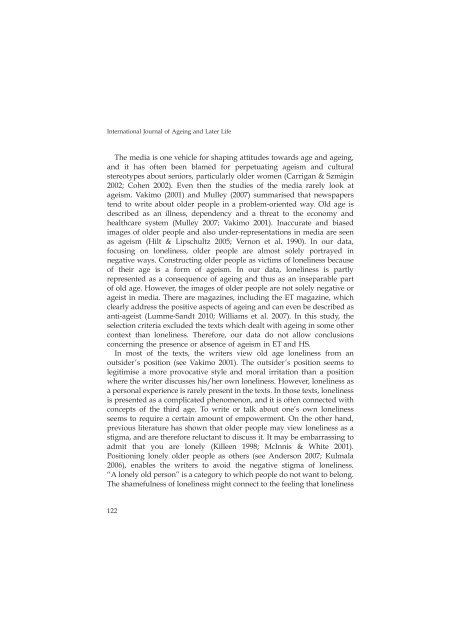Avaa tiedosto - TamPub - Tampereen yliopisto
Avaa tiedosto - TamPub - Tampereen yliopisto
Avaa tiedosto - TamPub - Tampereen yliopisto
You also want an ePaper? Increase the reach of your titles
YUMPU automatically turns print PDFs into web optimized ePapers that Google loves.
International Journal of Ageing and Later Life<br />
The media is one vehicle for shaping attitudes towards age and ageing,<br />
and it has often been blamed for perpetuating ageism and cultural<br />
stereotypes about seniors, particularly older women (Carrigan & Szmigin<br />
2002; Cohen 2002). Even then the studies of the media rarely look at<br />
ageism. Vakimo (2001) and Mulley (2007) summarised that newspapers<br />
tend to write about older people in a problem-oriented way. Old age is<br />
described as an illness, dependency and a threat to the economy and<br />
healthcare system (Mulley 2007; Vakimo 2001). Inaccurate and biased<br />
images of older people and also under-representations in media are seen<br />
as ageism (Hilt & Lipschultz 2005; Vernon et al. 1990). In our data,<br />
focusing on loneliness, older people are almost solely portrayed in<br />
negative ways. Constructing older people as victims of loneliness because<br />
of their age is a form of ageism. In our data, loneliness is partly<br />
represented as a consequence of ageing and thus as an inseparable part<br />
of old age. However, the images of older people are not solely negative or<br />
ageist in media. There are magazines, including the ET magazine, which<br />
clearly address the positive aspects of ageing and can even be described as<br />
anti-ageist (Lumme-Sandt 2010; Williams et al. 2007). In this study, the<br />
selection criteria excluded the texts which dealt with ageing in some other<br />
context than loneliness. Therefore, our data do not allow conclusions<br />
concerning the presence or absence of ageism in ET and HS.<br />
In most of the texts, the writers view old age loneliness from an<br />
outsider’s position (see Vakimo 2001). The outsider’s position seems to<br />
legitimise a more provocative style and moral irritation than a position<br />
where the writer discusses his/her own loneliness. However, loneliness as<br />
a personal experience is rarely present in the texts. In those texts, loneliness<br />
is presented as a complicated phenomenon, and it is often connected with<br />
concepts of the third age. To write or talk about one’s own loneliness<br />
seems to require a certain amount of empowerment. On the other hand,<br />
previous literature has shown that older people may view loneliness as a<br />
stigma, and are therefore reluctant to discuss it. It may be embarrassing to<br />
admit that you are lonely (Killeen 1998; McInnis & White 2001).<br />
Positioning lonely older people as others (see Anderson 2007; Kulmala<br />
2006), enables the writers to avoid the negative stigma of loneliness.<br />
‘‘A lonely old person’’ is a category to which people do not want to belong.<br />
The shamefulness of loneliness might connect to the feeling that loneliness<br />
122














